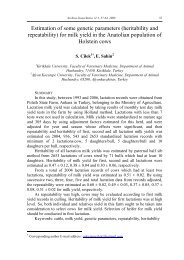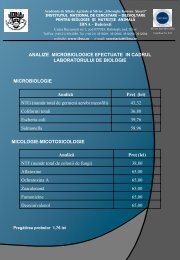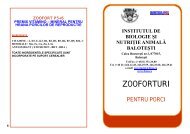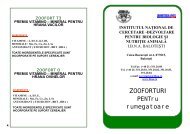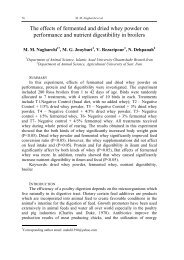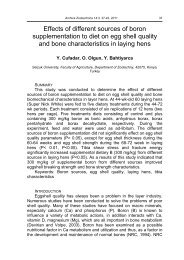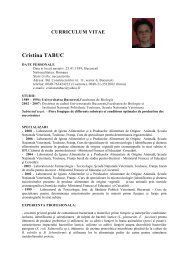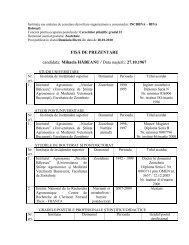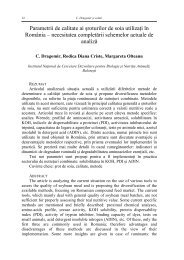Effects of Bio-Mos and Mycosorb feed supplementation on ... - IBNA
Effects of Bio-Mos and Mycosorb feed supplementation on ... - IBNA
Effects of Bio-Mos and Mycosorb feed supplementation on ... - IBNA
You also want an ePaper? Increase the reach of your titles
YUMPU automatically turns print PDFs into web optimized ePapers that Google loves.
Average egg weight was found, during the entire period, between 64.38 g <str<strong>on</strong>g>and</str<strong>on</strong>g><br />
65.50 g values, the differences between treatments being insignificant.<br />
Closer values have been found for the eggshell weight within the experimental<br />
groups <str<strong>on</strong>g>and</str<strong>on</strong>g> superior to the values found in the c<strong>on</strong>trol group, after the 1 st<br />
experimental week. A c<strong>on</strong>stant increase <str<strong>on</strong>g>of</str<strong>on</strong>g> the mean values <str<strong>on</strong>g>of</str<strong>on</strong>g> this character was<br />
observed in experimental groups, during weeks 1, 2 <str<strong>on</strong>g>and</str<strong>on</strong>g> 3, the differences between<br />
experimental <str<strong>on</strong>g>and</str<strong>on</strong>g> c<strong>on</strong>trol groups becoming statistically significant during the 4 th<br />
week <str<strong>on</strong>g>of</str<strong>on</strong>g> the experiment.<br />
Percentage <str<strong>on</strong>g>of</str<strong>on</strong>g> eggshell in the whole egg structure followed an almost similar<br />
evoluti<strong>on</strong>, the A1 group (+ 0.1% <str<strong>on</strong>g>Bio</str<strong>on</strong>g>-MOS ® ) having best results, with 9.75% shell<br />
in the entire egg weight. The differences between experimental <str<strong>on</strong>g>and</str<strong>on</strong>g> c<strong>on</strong>trol groups<br />
were found as significant (week 4 <str<strong>on</strong>g>and</str<strong>on</strong>g> mean values for the entire period) or even as<br />
very significant (week 3).<br />
Shell thickness was found better in the eggs bel<strong>on</strong>ging to A1 group (+ 0.1% <str<strong>on</strong>g>Bio</str<strong>on</strong>g>-<br />
MOS ® ), existing some significant statistic differences, during the 4 th experimental<br />
week, between A1+A2 groups <str<strong>on</strong>g>and</str<strong>on</strong>g> c<strong>on</strong>trol group.<br />
Shell index was found superior in experimental groups, as compared to the<br />
reference group. Thus, during week 3, the most pr<strong>on</strong>ounced differences were<br />
recorded, with a distinguished statistical significance<br />
Haugh index was found within normal limits, not any significant difference being<br />
found between the three groups, when the entire period was analyzed. During the<br />
4 th week, <str<strong>on</strong>g>feed</str<strong>on</strong>g> <str<strong>on</strong>g>supplementati<strong>on</strong></str<strong>on</strong>g> with both additives given beneficial results <strong>on</strong> the<br />
inner eggs’ quality, a l<strong>on</strong>ger lasting c<strong>on</strong>sistence <str<strong>on</strong>g>of</str<strong>on</strong>g> the dense albumen being<br />
noticed. Thus, during week 4, the results were found as distinguished significant<br />
when the groups supplemented with 0.1% <str<strong>on</strong>g>Bio</str<strong>on</strong>g>-MOS ® , respectively with 0.2%<br />
<str<strong>on</strong>g>Mycosorb</str<strong>on</strong>g> ® were compared to c<strong>on</strong>trol group.<br />
The better results obtained for the eggshell quality parameters could due to the<br />
prebiotic influence <strong>on</strong> the metabolic activity <str<strong>on</strong>g>of</str<strong>on</strong>g> the beneficial bacteria col<strong>on</strong>y<br />
within the layers’ intestine, which positively influenced mineral absorpti<strong>on</strong> rate,<br />
especially those <str<strong>on</strong>g>of</str<strong>on</strong>g> Ca 2+ <str<strong>on</strong>g>and</str<strong>on</strong>g> Mg 2+ (Roberfroid et al., 2000). However, other<br />
researches revealed that this could not be applied to P, because its availability<br />
mainly depends <strong>on</strong> the animals’ enzymatic equipment <str<strong>on</strong>g>and</str<strong>on</strong>g> sec<strong>on</strong>dary <strong>on</strong> the<br />
transmembranar transport mechanisms (Takahara et al., quoted by Chen et al.,<br />
2004).<br />
Although the best results was given by the hens received a basal diet supplemented<br />
with <str<strong>on</strong>g>Bio</str<strong>on</strong>g>-MOS ® + 0,1% (A1), superior values, as compared to c<strong>on</strong>trol group, were<br />
found for the eggs harvested from A2 group (+ 0,2% <str<strong>on</strong>g>Mycosorb</str<strong>on</strong>g> ® ). This could be<br />
due to a better D 3 vitamin - Ca 2+ interacti<strong>on</strong>, facilitated by the detoxifying agent<br />
presence, which eventually annihilated the mycotoxins existing in the fodder,<br />
which normally lead to an inactivati<strong>on</strong> <str<strong>on</strong>g>of</str<strong>on</strong>g> the D 3 vitamin (Lees<strong>on</strong> <str<strong>on</strong>g>and</str<strong>on</strong>g> Summers,<br />
1997).<br />
The results achieved by the hens in the experimental groups, c<strong>on</strong>cerning the<br />
eggshell quality parameters, had straight incidence <strong>on</strong> the percentage <str<strong>on</strong>g>of</str<strong>on</strong>g> eggs<br />
5


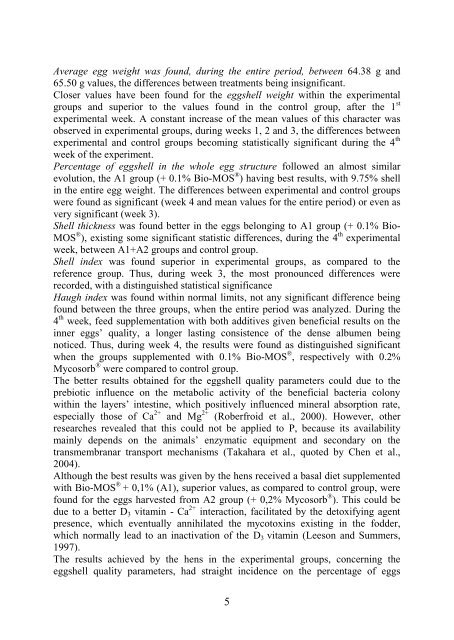
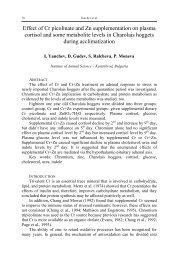
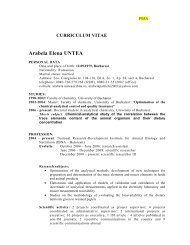
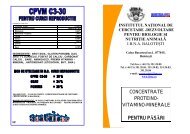
![( ) ( ) [ ] ( ) ( ) ( ) ( ) [ ]n ( ) ( ) [ ]n](https://img.yumpu.com/22443310/1/184x260/-n-n.jpg?quality=85)
